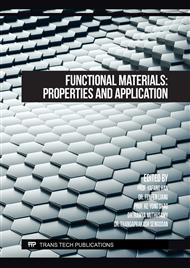[1]
Jin Tao, LI Jinguo, ZHAO Nairen, et al. Effects of Withdrawal Rate on Solidification Parameters and Microstructure of a Nickel-base Single Crystal Superalloy [J]. Journal of Materials Engineering, 2002(3):36-39.
Google Scholar
[2]
Tian S.G., Jiang C., Zhang S., et al. Influence and analysis of defects on creep behaviors of a single crystal nickel-based superalloy[J]. Materials Science and Engineering: A, 2014, 613:184-192.
DOI: 10.1016/j.msea.2014.06.095
Google Scholar
[3]
Hunt J.D.. Solidification and Casting of Metals. The Metals Society Press,(1979).
Google Scholar
[4]
Whitesell H.S., Li L., Overfelt R.A.. Influence of solidification variables on the dendrite arm spacings of Ni-based superalloys[J]. Metallurgical and Materials Transactions B (Process Metallurgy and, Materials Processing Science), 2000, 31(3):546-551.
DOI: 10.1007/s11663-000-0162-4
Google Scholar
[5]
Liu G., Liu L., Ai C., et al. Influence of withdrawal rate on the microstructure of Ni-base single-crystal superalloys containing Re and Ru[J]. Journal of Alloys and Compounds, 2011, 509 (19): 0-5872.
DOI: 10.1016/j.jallcom.2011.02.156
Google Scholar
[6]
Xu Chao, Zhou Lanzhang, Guo Jianting, et al. Effect of withdrawal rate on microstructures and mechanical properties of directionally solidified superalloy DZ445 [J]. Transactions of Nonferrous Metals Society of China, 2011, 21(4):754-761.
Google Scholar
[7]
ZHAO Nairen, Jin Tao, SUN Xiaofeng, et al. Effects of withdrawal rate on microstructure and mechanical property of single crystal superalloy SRR99. Chinese Journal of Materials Research , 2008, 22(1):46-52.
Google Scholar
[8]
Wilson B.C., Cutler E.R., Fuchs G.E.. Effect of solidification parameters on the microstructures and properties of CMSX-10[J]. Materials Science & Engineering A, Structural Materials: Properties, Microstructure and Processing, 2008, 479(1-2):356-364.
DOI: 10.1016/j.msea.2007.07.030
Google Scholar
[9]
Paraschiv A., Matache G., Puscasu C.. The effect of heat treatment on the homogenization of CMSX-4 Single-Crystal Ni-Based Superalloy[J]. Transportation Research Procedia, 2018, 29: 303-311.
DOI: 10.1016/j.trpro.2018.02.027
Google Scholar
[10]
Li L., Overfelt R. A.. Influence of directional solidification variables on the cellular and primary dendrite arm spacings of PWA1484[J]. Journal of Materials Science, 2002, 37(16): 3521-3532.
Google Scholar
[11]
Dariusz S.. Effect of Processing Parameters and Shape of Blade on the Solidification of Single-Crystal CMSX-4 Ni-Based Superalloy[J]. Metallurgical and Materials.
DOI: 10.1007/s11663-018-1347-z
Google Scholar
[12]
Liu Gang, LIU Lin, Zhao Xinbao, et al. Microstructure and microsegregation in a Ni-based single crystal superalloy directionally solidified under high thermal gradient [J]. Acta Metallurgica Sinica, 2010(01):79-85.
DOI: 10.3724/sp.j.1037.2009.00419
Google Scholar
[13]
Lamm M., Singer R.F.. The Effect of Casting Conditions on the High-Cycle Fatigue Properties of the Single-Crystal Nickel-Base Superalloy PWA 1483[J]. Metallurgical & Materials Transactions A, 2007, 38(6):1177-1183.
DOI: 10.1007/s11661-007-9188-4
Google Scholar
[14]
Epishin A., Link T.. Mechanisms of high-temperature creep of nickel-based superalloys under low applied stresses[J]. Philosophical Magazine, 2004, 84(19):1979-2000.
DOI: 10.1080/14786430410001663240
Google Scholar
[15]
Xue feng Z., Guang C., Yaya F., et al. Effects of Elevated Withdrawal Rate on the Microstructure and Segregation Behavior of a Nickel-base Single Crystal Superalloy[J]. Rare Metal Materials and Engineering, 2017, 46(5):1245-1250.
DOI: 10.1016/s1875-5372(17)30145-5
Google Scholar
[16]
Liu G., Liu L., Ai C., et al. Influence of withdrawal rate on the microstructure of Ni-base single-crystal superalloys containing Re and Ru[J]. Journal of Alloys and Compounds, 2011, 509(19):0-5872.
DOI: 10.1016/j.jallcom.2011.02.156
Google Scholar
[17]
Benjamin R., Carla M., Lais M.R., et al. Effect of porosity and eutectics on the high-temperature low-cycle fatigue performance of a nickel-base single-crystal superalloy[J]. Scripta Materialia, 2018, 155:139-143.
DOI: 10.1016/j.scriptamat.2018.06.036
Google Scholar
[18]
Matuszewski K., Rettig R., Matysiak H., et al. Effect of ruthenium on the precipitation of topologically close packed phases in Ni-based superalloys of 3rd and 4th generation[J]. Acta Materialia, 2015, 95:274-283.
DOI: 10.1016/j.actamat.2015.05.033
Google Scholar
[19]
Murakumo T., Kobayashi T., Koizumi Y., et al. Creep behaviour of Ni-base single-crystal superalloys with various γ' volume fraction[J]. Acta Materialia, 2004, 52(12):3737-3744.
DOI: 10.1016/j.actamat.2004.04.028
Google Scholar
[20]
Pollock T.M., Argon A.S.. Creep resistance of CMSX-3 nickel base superalloy single crystals[J]. Acta Metallurgica et Materialia, 1992, 40(1):1-30.
DOI: 10.1016/0956-7151(92)90195-k
Google Scholar
[21]
Pearson D.D., Lemkey F.D., Kear B.H.. Stress cqarsening of γ' and its influence in creep properties of a single crystal supperalloy [J].Superalloy, (1980).
DOI: 10.7449/1980/superalloys_1980_513_520
Google Scholar


